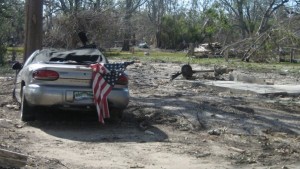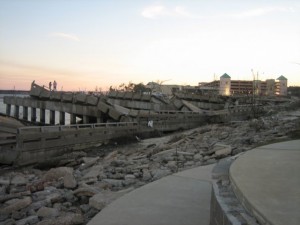
A Hurricane Katrina damaged car sits beside the slab of a south Mississippi home that was washed away by the Aug. 29, 2005 storm. Photo by Michael Newsom.
I can still remember the radio reporter saying Hurricane Katrina was going to be more destructive than Hurricane Camille, which generations of south Mississippians had used as the benchmark. Living in north Mississippi for almost my entire life with no experience with coastal storms, I still knew I needed to take cover.
On Aug. 28, 2005, I went to Hattiesburg, one hour’s drive north of the Coast. There, my assignment was to blog and file news stories during the storm for the Sun Herald, the Mississippi Coast newspaper that had hired me three months earlier when I graduated from the University of Mississippi with a journalism degree.
Katrina bore down on us the morning of Aug. 29, 2005. Even in Hattiesburg, I’d never seen winds like that. Trees were breaking all around the house I was staying in and the city was heavily damaged. Further south in Biloxi, where I lived, the damage was catastrophic. Many of my coworkers lost their homes and most of their possessions, but they worked hard telling the story of the storm while they dealt with their own personal tragedies. Some of my other colleagues were missing for days, trapped in their neighborhoods, cut off from the rest of the world by of flooding, debris and damage to the roads. I fared well. My second-floor apartment just north of the beach only had a broken window and some water damage to my guitar amplifier and some other furnishings inside. I was very lucky and I knew it.
The morning after Katrina, I headed south on U.S. 49 back to the Coast, but was turned around by the Mississippi Highway Patrol just south of Hattiesburg. I got on U.S. 98 and drove to Mobile, and then took Interstate 10 back toward Biloxi. I only saw a few cars on the interstate that was normally extremely busy. It was scary and surreal.
I knew the Biloxi-Ocean Springs Bridge had been destroyed in the storm. That was in my mind when I approached the long Interstate 10 Bridge over the Pascagoula River in Moss Point. There were no cars on it. I didn’t know if the roadway would collapse when I drove across it, but I had a job to get to, so I crossed the bridge. I later learned the bridge was damaged by ships that hit it during the storm, and one of the sections I drove over was completely replaced as part of $5.2 million in repairs.
As I approached Biloxi, I couldn’t believe the destruction. The large swaths of streets and yards covered by mounds of lumber, insulation and broken glass inspired a lot of cliché’s from journalists like “it looked like an atomic bomb went off, looked like a lumber yard, etc.” It was indeed frightening to see the raw power of nature on full display during the weeks before the area got cleaned up. As a lingering effect of being around the destruction for months, I still have some nightmares about hurricanes and being trapped in rising flood waters. I can’t even imagine what it’s like for those who actually went into the water and made it out alive while their relatives didn’t. Ten years later, my heart still breaks for those people, whom I spoke to while I worked in 2005.
I remember seeing the black brackish water in east Biloxi, a peninsula, which was mostly submerged for hours. It was still there in some low spots. It also stained everything, including the clothing of the people I saw walking the streets of my town. They were in it hours before. Many of them were still muddy hours after the storm.
My first afternoon working after Hurricane Katrina was spent talking to the search and rescue teams as they assembled at the Mississippi Coast Coliseum to go out looking for those still trapped in the rubble. They knew they had an incredible task ahead as tens of thousands of homes were destroyed by Katrina’s record storm surge, which was as high as 28 feet in some places.

A souvenir shop along the beach in Biloxi is left barely standing after Hurricane Katrina, which happened on Aug. 29, 2005, a few months before . Photo by Michael Newsom
Being a reporter in Katrina’s aftermath was challenging, emotionally for sure, but also technologically. There was almost no communication – no phones, cell phones or Internet. Miraculously, I was able to call my family and tell them I was OK after the storm passed, but for days, many of my friends had no idea how I was. To interview someone, you had to guess where they might be, then go find them. I imagine it was something like being a reporter in the 1800s.
Some of my days involved tracking down officials for interviews. I went to a location where I guessed a certain official would be, then if they weren’t there, I would leave a message asking them to come by the newspaper. Sometimes they did, but sometimes they didn’t get the message. Other times, I found them before they got the word I was looking for them. They were all very tired and shell-shocked, and many of them had also lost their homes.
Once we had the information, we had to write a story that was in some cases dictated to a person who could physically put it on a page in Columbus, Georgia, at a newspaper that was owned by the same chain as the Sun Herald. Each morning, the papers were driven to from Columbus to Biloxi and handed out for free. Every Sun Herald staffer took turns passing papers out between their reporting assignments and other duties. It wasn’t uncommon to see storm victims step out of lines for water and ice to get their hands on a free Sun Herald. That’s about the most powerful testament to the importance of journalism that I can think of. It has always stuck with me.
The first few weeks after Katrina were a complete blur. I was working most days and only going home to my apartment, which had no electricity, to sleep. The water wasn’t safe to drink for days. Each night, I sat in the darkest darkness I’ve ever experienced. The populous Mississippi Coast, the second-largest metropolitan area in Mississippi, was completely black at night and eerily quiet at times. On nights when it was cool enough to sleep inside, searchlights from military helicopters sometimes awoke me when the spotlight shined into my open apartment windows. Other nights, I tried to sleep on my porch. The entire time, I rolled around trying to get comfortable on the hard wood floor while being bitten by mosquitoes. I was nonetheless immensely grateful I still had a place.
The number of people who were truly suffering after Katrina was staggering. It’s estimated that more than 130,000 south Mississippi homes were damaged or destroyed. Some 50,000 homes had flood damage, and about 35,000 of those homes were not covered by flood insurance. The storm’s human toll was unbelievable. Katrina killed 1,833 people in five states, including 231 in Mississippi, where the storm made landfall near the Mississippi-Louisiana state line. Its eye moved up the Pearl River, passing directly over Stennis Space Center in Hancock County.
On the pages of the Sun Herald, we told the stories of the Mississippi victims, with each staffer taking turns profiling those who died. Our paper wrote about Mississippi’s post-Katrina destruction being mostly ignored by the national media, who had focused on the situation unfolding in New Orleans instead.
Biloxi city government and the military were my beats. I interviewed entire families staying in shelters. I covered presidential visits to the Coast and stood within a couple of feet of President George W. Bush as he talked with victims, volunteers and local officials. I wrote a feature story on the first bar open on the entire Coast after the storm, interviewing many there who’d lost their homes and possessions to Katrina, but were happy for a moment while they ate cheeseburgers and drank cold beers at a TGI Fridays in Gulfport. I covered the military’s impressive response to the storm and the many contributions they made to rebuilding the Coast and helping those in need. I also covered the debate about how to handle the many obstacles the city of Biloxi faced in determining its pathway out of the rubble. Removing the debris from Mississippi was a monumental task alone.
One story still sticks out to me. The storm happened a little over a week shy of the fourth anniversary of the Sept. 11 terrorist attacks. I was assigned to write a Sunday centerpiece about people who helped out after 9/11 who were also on the Coast helping out after Katrina. I drove all over south Mississippi, going from shelter to shelter, aid center to aid center, leaving messages for anyone who would have helped during 9/11. I found plenty of them. I was moved and still am by their selflessness and love of their fellow man. The Coast benefitted from 1 million volunteers, according to the Sun Herald, and surely wouldn’t be where it is today without them.
For our work during and after Hurricane Katrina, the Sun Herald news team was awarded the 2006 Pulitzer Prize for Public Service, which is journalism’s highest honor. I was only a cog in the wheel, part of a larger team of amazing journalists. I worked at the Sun Herald for eight years before taking my current job in public relations at Ole Miss. For most of those eight years, Katrina was a major theme of our reporting as the Coast continued to recover. The very last story I wrote for the paper was about the eight-year anniversary of Katrina. It was published on Aug. 25, 2013, my last day at the Sun Herald.
Ten years later, south Mississippi has prevailed over Katrina thanks to the indomitable spirit of its people. I will never forget the important lesson they taught me as a young man finding my way in the world: Mankind can overcome any tragedy if we work hard and help each other.
